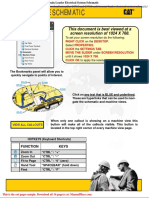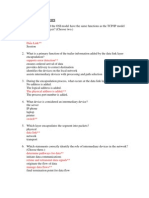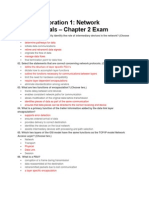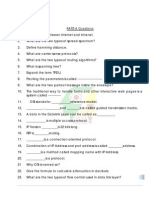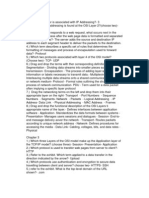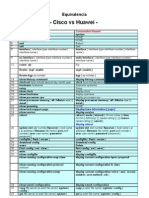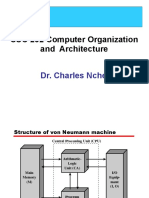John Mays Chapter 7
John Mays Chapter 7
Uploaded by
mays27945Copyright:
Available Formats
John Mays Chapter 7
John Mays Chapter 7
Uploaded by
mays27945Copyright
Available Formats
Share this document
Did you find this document useful?
Is this content inappropriate?
Copyright:
Available Formats
John Mays Chapter 7
John Mays Chapter 7
Uploaded by
mays27945Copyright:
Available Formats
Module 7 ISP Services
Name John Mays
7.1.1.1 1. What makes up the consumer market for ISPs? 2. What makes up the enterprise market for ISPs? 3. What is forcing service providers to offer new services? 4. What are key services that ISPs can provide to all customers? 5. What do organizations have access to when ISPs offer managed services? 6. What does it mean that some managed services are hosted? 7.1.2.1 7. What are the two measures of reliability? 8. What is a definition for the mean time between failure (MTBF)? 9. What is a definition for mean time to repair (MTTR)? 10. What are two things an ISP can do to prevent an equipment failure or preventing the network or service becoming unavailable? 11. What is a definition of availability? 12. What is meant by five-9's standard of availability? What is a service that traditionally requires five-9's standard of availability? 13. What do ISPs do to ensure accessibility? 14. What happens if one device fails in a redundant configuration? Individuals in homes make up the consumer market. Large, multinational companies make up the enterprise market. Escalating customer expectations and increasingly competitive markets are forcing ISPs to offer new services Email, web hosting, media streaming, IP telephony, and file transfer are important services that ISPs can provide to all customers. The leading network technologies and applications without having to make large investments in equipment and support. The service provider hosts the applications in its facility instead of at the customer site. Mean time between failure (MTBF) and mean time to repair MTTR measure of the reliability of a device or system The total corrective maintenance time divided by the total number of corrective maintenance actions during a given period of time. 1. an ISP may purchase expensive service agreements for critical hardware to ensure rapid manufacturer 2. An ISP may also choose to purchase redundant hardware and keep spare parts on site. The percentage of time that a resource is accessible. only a very small percentage (0.001%) of downtime is acceptable. telephone services By doubling up on network devices and servers using technologies designed for high availability. The other one can take over the functions automatically.
7.1.1.2
7.2.1.1
15. What do ISP servers need to be able to support? 16. What are the two TCP/IP transport protocols? 17. What do many of the key services provided to ISP customers depend on? 18. What do Application Layer protocols specify? 19. What are the following protocols used for?
Mobile phones as televisions, PCs as telephones, and televisions as interactive gaming stations with entertainment. TCP and UDP DNS
7.2.1.2
DNS used to resolve Internet names to IP address HTTP used to transfer files that make up the web pages of the World Wide Web SMTP used for the transfer of mail message and attachments Telnet used to provide remote access to severs and networking devices FTP used for interactive file transfer between systems
20. What is the responsibility of the lower layers? 21. What is the job of the Transport Layer? 7.2.1.3 22. List the three similarities of the TCP/IP model and the OSI model.
Get the data to the device Deliver the right data to the appropriate application 1.both use layers to visualize the interaction of protocols and services 2.the transport and network layers are comparable 3.the networking field uses both models when referring to protocol interaction 1. OSI model breaks the function of the TCP/IP Application Layer into distinct layers. The upper three layers of the OSI model specify the same functionality as the Application Layer of the TCP/IP model. 2. The TCP/IP suite does not specify protocols for the physical network interconnection. The two lower layers of the OSI model are concerned with access to the physical network and the delivery of bits between hosts on a local network. Network access The TCP/IP model is based on actual developed protocols and standards, whereas the OSI model is a theoretical guide for how protocols interact. a reliable, guaranteed-delivery protocol TCP specifies the methods hosts use to acknowledge the receipt of packets, and requires the source host to resend packets that are not acknowledged. pipeline, or a persistent connection, between hosts a connection-oriented protocol.
23. List the two differences of the TCP/IP model and the OSI model.
24. What are the two lower layers of the OSI model are concerned with? 25. What is the TCP/IP model is based on? How does this compare to the OSI model? 7.2.2.1 26. What is TCP? 27. What does TCP specify? What does TCP require? 28. What is TCP is often compared to? What is TCP referred to as?
29. What does TCP require to keep track of the individual conversations between source and destination hosts? 30. What is UDP? 31. What does UDP provide? 32. What is not provided by UDP? 33. What can applications that use UDP tolerate? 34. What is an example of a UDP application? 7.2.2.2 35. What do applications such as databases, web pages, and email need to have? 36. What can any missing data cause? 37. How does TCP identify each byte or octet? 38. What happens when segments are passed to the Internet Layer? 39. What is the process known as? 7.2.2.3 40. What must occur between the source and destination hosts before a TCP session can be used? 41. What is sent by the source host in the first step? 42. What are the two purposes of the SYN message?
TCP requires overhead a very simple, connectionless protocol It provides low overhead data delivery It does not provide error checking, guaranteed data delivery, or flow control. UDP can tolerate small amounts of missing data. Internet radio data arrive at the destination in its original condition, for the data to be useful. the messages to be corrupt or unreadable. with a sequence number places each segment in a packet for transmission. encapsulation. the source and destination hosts exchange messages to set up the connection over which data segments can be sent. A type of message, called a Synchronization Message, or SYN, to begin the TCP session establishment process. 1.It indicates the intention of the source host to establish a connection with the destination host over which to send the data. 2.It synchronizes the TCP sequence numbers between the two hosts, so that each host can keep track of the segments sent and received during the conversation. a synchronization acknowledgment, or SYN-ACK, message. the sending host receives the SYN-ACK and it sends an ACK message back to complete the connection setup. Data segments can now be reliably sent. a three-way handshake. a timer the timer expires, and the source assumes the message is lost. Its re-sent.
43. What does the destination host reply with in the second step? 44. What is received by the sending host in the last step? What is sent by the sending host in the last step? 45. What is this three step process called? 7.2.2.4 46. When a host sends message segments to a destination what is started? 47. What happens if the source host does not receive an acknowledgement from the destination within the allotted time? 48. What happens to the portion of the message that was not acknowledged? 49. How are TCP messages reassembled
at the destination host?
7.2.3.1
50. Why does UDP have a much lower overhead? 51. Why is UDP often called an unreliable delivery protocol? 52. List six key Application Layer protocols that use UDP.
Because it is not connection-oriented and does not provide the sophisticated retransmission, sequencing, and flow control mechanisms of TCP Because there is no guarantee that a message has been received by the destination host. 1. Domain Name System (DNS) 2. Simple Network Management Protocol (SNMP) 3. Dynamic Host Configuration Protocol (DHCP) 4. RIP routing protocol 5. Trivial File Transfer Protocol (TFTP) 6. Online games Transport Layer
7.2.4.1
Complete the activity on 7.2.3 page 2. 53. What layer is responsible for the task of managing multiple, simultaneous communication processes? Which protocols do this? 54. How do TCP and UDP differentiate the segments and datagrams for each application? 55. How is a destination port number assigned? 56. What does TCP or UDP do with segments as they are received for a specific port? 57. What port numbers are usually assigned to server processes? 58. What do well-known port numbers enable a client application to do? 59. How are source port numbers assigned? 60. What are these port number assignments similar to? 61. What is a socket?
The segments and datagrams for each application, both TCP and UDP have header fields that can uniquely identify these applications for data communications purposes. Depending on whether the message is a request or a response. places the incoming segments in the appropriate queue 0 to 1023. Enable a client application to assign the correct destination port when generating a request for services. From the port range 1024 to 65535 a return address for the requesting application. The combination of the Transport Layer port number and the Network Layer IP address of the host uniquely identifies a particular application process running on an individual host device. Consisting of the source and destination IP addresses and port numbers, is also unique and identifies the specific conversation between the two hosts. Enable multiple processes running on a client to distinguish themselves from each other, and multiple connections to a server process to be distinguished from each other. Human-readable names into machine-readable IP addresses that can be used to communicate over the network. To help users reach the resource they need without having to remember the complex IP address. The use of a single HOSTS file located on a centrally
7.2.4.2
7.2.4.3
62. What is a socket pair? 63. What do sockets enable? 7.3.1.1 64. What are network naming systems designed to translate? 65. How are network naming systems a human convenience? 66. How were host names and IP
7.3.1.2
addresses of computers managed in the early days of the Internet? 67. What was Domain Name System (DNS) created for? 68. How is the HOSTS file still used? 7.3.2.1 Complete the Lab Activity on 7.3.1 page 2. 69. What is the structure of DNS like? 70. How does DNS form a hierarchy? 71. What does a DNS server do when it receives a request for a name translation that is not within that DNS zone? 72. What makes the DNS system very scalable? 73. What are the three parts that make up the DNS naming system? 74. What is a resource record used to identify? 75. What does the domain namespace refers to? 76. What do the DNS servers maintain? 77. What do DNS servers attempt to resolve? 78. What are resolvers? 79. What does a resolver do when a domain name is used? 80. What devices should be loaded with resolvers? 81. What do the different top-level domains represent? 82. What hierarchy does DNS rely on? 83. What does the resource records contain? 84. Why is the name H1.cisco.com referred to as a fully qualified domain name (FQDN) or DNS name? 85. When the DNS server receives a request from the client resolver, what does it check first? 86. What does the server do if it is unable to resolve the IP address locally? 87. What does the cached information enable the DNS server to do? 88. Why should DNS servers not cache information too long?
administered server. created for domain name to address resolution Local HOSTS file is created when TCP/IP is loaded on a host device. hierarchical Uses domain names to form the hierarchy. The DNS server forwards the request to another DNS server within the proper zone for translation. Host name resolution is spread across multiple servers. Resource Records and Domain Namespace, Domain Name System Servers, Resolvers type of host, a host IP address, or a parameter of the DNS database. the hierarchical naming structure for organizing resource records the databases that store resource records and information about the domain namespace structure. client queries using the domain namespace and resource records it maintains in its zone database files client queries using the domain namespace and resource records it maintains in its zone database files queries the DNS server to translate that name to an IP address. the type of organization or the country of origin.
7.3.2.2
7.3.2.3
7.3.2.4 7.3.3.1
because it defines the exact location of the computer within the hierarchical DNS namespace. it first checks the local DNS records it has cached in its memory. the server uses its resolver to forward the request to another preconfigured DNS server. enables the DNS server to reply more quickly to subsequent resolver requests, because the server first checks the cache records before querying other DNS servers. because host name records do periodically change. If a DNS server had old information cached, it may give out the wrong IP address for a computer.
7.3.3.3 7.3.3.4
Complete the Lab Activity on 7.3.3 page 2. 89. What do Dynamic Updates enable DNS client computers to do? 90. What are the two DNS zones? 91. What is the role of a forward lookup zone? 92. When is a forward lookup zone commonly found? 93. What is the role of a reverse lookup zone? 94. Why do many private networks choose to implement their own local reverse lookup zones? 95. How can reverse lookups on IP addresses be found? 96. What does it mean that a primary zone on a DNS server is authoritative? 97. What is a secondary zone?
enable DNS client computers to register and dynamically update their resource records with a DNS server whenever changes occur. forward lookup or reverse lookup zone a standard DNS zone that resolves fully qualified domain names to IP addresses when surfing the Internet. resolves an IP address to a fully qualified domain name. to help identify computer systems within their network. be found using the ping -a [ip_address] command. When you have a primary zone on a DNS server. a read-only backup zone maintained on a separate DNS server than the primary zone. caching-only DNS servers. These servers are configured to forward all name resolution requests to the root servers on the Internet. by reducing the frequency that DNS queries that are forwarded to the root servers Root server
7.3.4.1
Complete the Lab Activity on 7.3.3 page 5. 98. What type of servers do ISPs typically maintain? 99. How does the large cache of DNS lookups reduce network bandwidth? 100. Where are all name resolution requests forwarded with an ISP DNS Server? (Look at the graphic to the right of text.) 101. Where are all name resolution requests forwarded with a local DNS Server? (Look at the graphic to the right of text.) 102. What is the local DNS Server responsible for? (Look at the graphic to the right of text.) 103. Why must a minimum of two DNS servers be provided when an organization registers a domain name on the Internet? 104. What is a good idea to do when hosting multiple DNS servers with zone information? 105. How can DNS servers be protected? 106. What are some additional services that are provided by ISPs?
ISP DNS server
it has name-to-IP mappings of any host within the zone. If users type in a domain name that cannot be resolved, they cannot access the resource. locate on different physical networks. Use firewalls and other security measures. email hosting website hosting e-commerce sites file storage and transfer message boards and blogs streaming video and audio services
7.3.4.2
7.4.1.1
7.4.2.1
107. What are some of the most common TCP/IP Application Layer protocols? Complete the activity on 7.4.1 page 2. 108. What version of HTTP is currently used by most ISPs to provide web-hosting services? 109. What does this version of HTTP permit? 110. Why is HTTP not a secure protocol? 111. What does HTTPS use to secure data as it travels between the client and server?
Are HTTP, FTP, SMTP, POP3, and IMAP4. version 1.1 permits persistent connections, so that multiple request and response messages can use the same connection, reducing the time it takes to initiate new TCP sessions. The request messages send information to the server in plain text that can be intercepted and read. use authentication and encryption to secure data as it travels between the client and server. a uniform resource locator (URL) Protocol being used Domain name of the server being accessed Location of the resource on the server, make indirect network connections to other network services a device in the communications stream that acts as a server to the client and as a client to a server. 1. Speed 2. Security
7.4.2.2
112. What is used to locate the server and a specific resource? 113. What are three things a uniform resource locator (URL) identifies? 114. What does a proxy server allows clients to make? 115. What is a proxy? 116. What are three reasons why proxies are used?
7.4.2.3
7.4.2.4
117. How does HTTPS differ from HTTP? 118. What affect does HTTPS have on the server due to the encryption and decryption of traffic? 119. When should HTTPS be used to keep server performance up? Complete the Activity on 7.4.2 page 5. 120. What are the 2 FTP implementations that are included in the protocol? 121. Why does FTP require two connections to exist between the client and server? 122. What is the PI function? 123. What does the control information include? 124. What is the DTP? 125. When does DTP close a connection?
3. Filtering data stream is encrypted with SSL before being transported across the network. HTTPS creates additional load and processing time on the server should only be used when necessary, such as when exchanging confidential information. interpreter (PI) and a data transfer process (DTP). PI and DTP define two separate processes that work together to transfer files. the main control connection between the FTP client and the FTP server. commands to navigate through a file hierarchy and renaming or moving files a separate data transfer function. automatically when the file transfer is complete. Active Data Connections and Passive Data Connections Passive Data Connections
7.4.3.1
7.4.3.2
126. What are the two types of data transfer connections supported by FTP? 127. Which connection is initiated by a client?
7.4.4.1
128. Which connection is initiated by the FTP server? 129. Which type of FTP connection is not permitted by firewalls? 130. Where are email messages stored? 131. What does an email server do when it receives a message? 132. What does an email server do if the recipient is not located on its local database? 133. Which email protocol is used to send email? 134. Which email protocols are used to retrieve email? 135. What two things must happen for SMTP applications to work properly? 136. What is required in a message header? 137. What port number does SMTP use? 138. Why does SMTP spool messages? 139. When is a message returned as undeliverable?
Active Data Connections Passive Data Connections in databases on mail servers. it checks to see if the recipient domain is located on its local database. it sends a DNS request to determine the mail server for the destination domain. The Application Layer process that sends mail, either from a client to a server or between servers, implements SMTP. Application Layer protocols: POP3 or IMAP4. the mail message must be formatted properly and SMTP processes must be running on both the client and server. a properly formatted recipient email address and a sender address. port 25. to be sent at a later time. If the message is still not delivered after a predetermined expiration time, the recipient email address. the account and the domain name of the server. Mail servers are identified in DNS by an MX. MX is a type of resource record stored on the DNS server. the email is returned to the sender as undeliverable. Because email messages are downloaded to the client and removed from the server, there is not a centralized location where email messages are kept. Port 110 Because POP3 does not store messages,
7.4.4.2
7.4.4.3
140. What is one of the required fields in an email message header? 141. What does the @ symbol separate? 142. How are mail servers identified in DNS? What is MX? 143. What does the mail server do if it receives an email message with an account that does not exist? 144. When is email deleted on the email server when using POP3? 145. What port number does POP3 use? 146. Why is POP3 undesirable for a small business that needs a centralized backup solution? 147. Why is POP3 desirable for an ISP?
7.4.4.4
because it alleviates their responsibility for managing large amounts of storage for their email servers. when the user connects to an IMAP-capable server, copies of the messages are downloaded to the client application.
7.4.4.5
148. How is IMAP unlike POP3?
149. What are the advantages to using IMAP for small to medium-sized businesses?
1. IMAP can provide long-term storage of email messages on mail servers and allows for centralized backup. 2. It also enables employees to access email messages from multiple locations, using different devices or client software. 3. The mailbox folder structure that a user expects to see is available for viewing regardless of how the user accesses the mailbox. 4. When a user decides to delete a message, the server synchronizes that action and deletes the message from the server.
150. What are two reasons why IMAP may not be a good choice for an ISP?
1. It can be expensive to purchase and maintain the disk space to support the large number of stored emails. 2. Additionally, if customers expect their mailboxes to be backed up routinely, that can further increase the costs to the ISP
You might also like
- Caterpillar 247b2 and 257b2 Multi Terrain Loader Electrical System SchematicDocument1 pageCaterpillar 247b2 and 257b2 Multi Terrain Loader Electrical System Schematicjustin100% (64)
- MCD 5000 Deskset User GuideDocument110 pagesMCD 5000 Deskset User GuideZeljko M BoskovicNo ratings yet
- D17251GC20 Sg1 (Full Permission)Document440 pagesD17251GC20 Sg1 (Full Permission)shuvrabd100% (1)
- Examenes de CiscoDocument37 pagesExamenes de CiscoClevemanNo ratings yet
- Data Communication and Networking 1Document6 pagesData Communication and Networking 1Lemss DeveraNo ratings yet
- ExamsDocument24 pagesExamsYesenia PerezNo ratings yet
- Examen3ccna1v5 0Document5 pagesExamen3ccna1v5 0DaniloSoto16No ratings yet
- Ccna1 AnswersDocument63 pagesCcna1 AnswersTricia Mutetwa SakarombeNo ratings yet
- Module 2 Exam Answers: Physical Data LinkDocument35 pagesModule 2 Exam Answers: Physical Data LinkLukáš MračekNo ratings yet
- CCNA1 Chapter 3Document8 pagesCCNA1 Chapter 3wahyuNo ratings yet
- 3Document8 pages3Bryan YaranonNo ratings yet
- CCNA 1 Chapter 3 v5.0 Exam Answers 2015 100Document5 pagesCCNA 1 Chapter 3 v5.0 Exam Answers 2015 100Vidyanath Reddy BNo ratings yet
- CCNA Final Exam ReviewerDocument50 pagesCCNA Final Exam ReviewerBdick CruzNo ratings yet
- Final ExamDocument18 pagesFinal ExamgenericnamezipNo ratings yet
- MTA SMTP: 28. Which Email Components Are Used To Forward Mail Between Servers? (Choose Two.) MDA Imap POPDocument13 pagesMTA SMTP: 28. Which Email Components Are Used To Forward Mail Between Servers? (Choose Two.) MDA Imap POPGokuldeep MuralyNo ratings yet
- CCNA 1 Chapter 3 v5 EspanolDocument7 pagesCCNA 1 Chapter 3 v5 EspanolJames Jim Huamán CamachoNo ratings yet
- ccna 1 Chapter 3 v5 0 AnswersDocument4 pagesccna 1 Chapter 3 v5 0 AnswersPriscila Beatriz Cabrera CabralNo ratings yet
- CCNA Network Fundamentals Chapter 2 Exam AnswersDocument27 pagesCCNA Network Fundamentals Chapter 2 Exam AnswersSelvir KamberovicNo ratings yet
- CNDocument5 pagesCNMudit JainNo ratings yet
- Data Communications and Networking 1 Midterm Quiz 1Document15 pagesData Communications and Networking 1 Midterm Quiz 1Santi SeguinNo ratings yet
- What Is The Automated Service That Matches Resource Names With The Required IP Address? SSHDocument6 pagesWhat Is The Automated Service That Matches Resource Names With The Required IP Address? SSHSickoDaemon SVNo ratings yet
- Semester 1 Chapter 2 Communicating Over The Network V 4.0Document4 pagesSemester 1 Chapter 2 Communicating Over The Network V 4.0Elvedin SalihovicNo ratings yet
- CCNA 1 v6 Chapter 3Document8 pagesCCNA 1 v6 Chapter 3Webber JonxNo ratings yet
- Unit 4-I MDocument4 pagesUnit 4-I Mnitin kachhiNo ratings yet
- Module Iii: Lan Switching and Wireless Chapter 3: VlansDocument4 pagesModule Iii: Lan Switching and Wireless Chapter 3: VlansEuisMSANo ratings yet
- Cnunit 4Document21 pagesCnunit 4mouryasaikarnati23No ratings yet
- CCNA I Cap 3Document4 pagesCCNA I Cap 3alexberceniNo ratings yet
- Department of Computer Science and Engineering: PREPARED BY: Mr. D. Ramkumar - A.P-CSEDocument38 pagesDepartment of Computer Science and Engineering: PREPARED BY: Mr. D. Ramkumar - A.P-CSEanish.t.pNo ratings yet
- Jarkom CCNA ExamDocument29 pagesJarkom CCNA ExamCintia NurliyanaNo ratings yet
- INFRASTRUCTURE VRAGEN Met Meeste AntwoordenDocument10 pagesINFRASTRUCTURE VRAGEN Met Meeste Antwoordenprojectjr2 ProfsNo ratings yet
- CN Lab Manual 2018Document121 pagesCN Lab Manual 2018Suresh RamanujamNo ratings yet
- Unit 1Document54 pagesUnit 1AngayarkanniNo ratings yet
- CybeOps QuestionsDocument21 pagesCybeOps QuestionsJayz JoeNo ratings yet
- Networks 1Document7 pagesNetworks 1Ahmed AbdoNo ratings yet
- CCNA 1 v7 Modules 14 - 15: Network Application Communications Exam AnswersDocument15 pagesCCNA 1 v7 Modules 14 - 15: Network Application Communications Exam AnswersAdha Estu RizqiNo ratings yet
- Cisco 1 Reviewer For Final ExamDocument9 pagesCisco 1 Reviewer For Final ExamAlNo ratings yet
- CS8581-Networks Lab Manual (2020-2024)Document50 pagesCS8581-Networks Lab Manual (2020-2024)john wickNo ratings yet
- Chapter3 SummaryDocument42 pagesChapter3 Summaryandrewakram57No ratings yet
- TCP IP ApplicationsDocument10 pagesTCP IP ApplicationsJetesh DevgunNo ratings yet
- Sheet ProtocolDocument10 pagesSheet Protocolmahmoudam.weschoolNo ratings yet
- Programming With TCP/IP - Best PracticesDocument31 pagesProgramming With TCP/IP - Best PracticesmrwanzNo ratings yet
- Chapter 3 Exam Answers 2019 100 Full PDFDocument14 pagesChapter 3 Exam Answers 2019 100 Full PDFRazvan AlexandruNo ratings yet
- CCNA 1 v7.0 Final ExamDocument62 pagesCCNA 1 v7.0 Final ExamDonald TientcheuNo ratings yet
- Part-A (University Questions) : Sengunthar College of Engineering, TiruchengideDocument24 pagesPart-A (University Questions) : Sengunthar College of Engineering, TiruchengideAlwarsamy RamakrishnanNo ratings yet
- Computer Netwirk 2 Marks 1Document40 pagesComputer Netwirk 2 Marks 1Amirtharajan RengarajanNo ratings yet
- CN ShortDocument6 pagesCN ShortManinder KalsiNo ratings yet
- Ccna Exam 14-15 AnswersDocument10 pagesCcna Exam 14-15 Answerstomasjohn010No ratings yet
- FAQ'sDocument24 pagesFAQ'sduvvuruvitNo ratings yet
- Computer Networks PDFDocument29 pagesComputer Networks PDFkumarishu125No ratings yet
- Chapter 2B-CommunicationDocument30 pagesChapter 2B-Communicationsiraj mohammedNo ratings yet
- Take Assessment - Enetwork Final Exam - Ccna Exploration: Network Fundamentals (VERSION 4.0) - ANSWERS - 2011 - 2012Document6 pagesTake Assessment - Enetwork Final Exam - Ccna Exploration: Network Fundamentals (VERSION 4.0) - ANSWERS - 2011 - 2012Juan Jose TorresNo ratings yet
- Chapter Quiz CiscoDocument4 pagesChapter Quiz CiscoRalph Maniquis AustriaNo ratings yet
- Quality of Service in A Software-Defined Network: Dennis Chan University of California, Los AngelesDocument14 pagesQuality of Service in A Software-Defined Network: Dennis Chan University of California, Los AngelesBob BobboNo ratings yet
- Major Networking Concepts: Reference Models: Kashif AmjadDocument48 pagesMajor Networking Concepts: Reference Models: Kashif AmjadKashif AmjadNo ratings yet
- Network PROTOCOLSDocument11 pagesNetwork PROTOCOLSRose of sharonNo ratings yet
- Chapter 5Document16 pagesChapter 5Honor SwiftNo ratings yet
- Cisco Interview QuestionsDocument8 pagesCisco Interview QuestionsssprudhviNo ratings yet
- Computer Networks - Most Asked Interview QuestionsDocument29 pagesComputer Networks - Most Asked Interview QuestionsKhan ArmanNo ratings yet
- Cisco Certified Network Associate (CCNA) and Cisco Certified Network Professional (CCNP): Mastering Network Automation and Programmability Study GuideFrom EverandCisco Certified Network Associate (CCNA) and Cisco Certified Network Professional (CCNP): Mastering Network Automation and Programmability Study GuideNo ratings yet
- Hacking Network Protocols: Unlocking the Secrets of Network Protocol AnalysisFrom EverandHacking Network Protocols: Unlocking the Secrets of Network Protocol AnalysisNo ratings yet
- Network Programming with Go: Code Secure and Reliable Network Services from ScratchFrom EverandNetwork Programming with Go: Code Secure and Reliable Network Services from ScratchNo ratings yet
- 1909 OP FPS0 - Activation - Merged - Client - USDocument5 pages1909 OP FPS0 - Activation - Merged - Client - USServicios Administrativos SAPNo ratings yet
- ASSIGNMENTDocument5 pagesASSIGNMENTAga ChimdesaNo ratings yet
- Insight (UK)Document8 pagesInsight (UK)João RibeiroNo ratings yet
- Week 2 LectureDocument12 pagesWeek 2 Lectureapi-218675166No ratings yet
- EC - A2 - Tests - Vocabulary Check 4ADocument1 pageEC - A2 - Tests - Vocabulary Check 4AEwa KrzyżanowskaNo ratings yet
- Differential Pulse Code ModulationDocument12 pagesDifferential Pulse Code ModulationKiranNo ratings yet
- Voucher Management SystemDocument9 pagesVoucher Management SystemRabeya Bashri BushraNo ratings yet
- CSC 413 - Software Development 5. Strategy Design Pattern: 2/3/18 John RobertsDocument5 pagesCSC 413 - Software Development 5. Strategy Design Pattern: 2/3/18 John Robertseveswan2008No ratings yet
- 05how To Read A Synopsys Liberty FileDocument16 pages05how To Read A Synopsys Liberty FileHa TranNo ratings yet
- XRAY RRF PM EchecklistsDocument4 pagesXRAY RRF PM EchecklistsRogerio CastroNo ratings yet
- Alumni Newsletter August 2021Document41 pagesAlumni Newsletter August 2021Sarvesh DubeyNo ratings yet
- Markian Mumba: Software DeveloperDocument1 pageMarkian Mumba: Software DeveloperMark MumbaNo ratings yet
- Comandos Huawei ProfDocument5 pagesComandos Huawei ProfSoulRednavNo ratings yet
- Ontella PicDeck ADocument6 pagesOntella PicDeck ASesha Sailendra UppalapatiNo ratings yet
- Cloneapp ManualDocument17 pagesCloneapp ManualosmartkdNo ratings yet
- Affiliate Marketing Tools BloggingCageDocument17 pagesAffiliate Marketing Tools BloggingCagechetan kapoor100% (1)
- Department of Computer Engineering: Assignment No-4Document3 pagesDepartment of Computer Engineering: Assignment No-460 Zaid PeerzadeNo ratings yet
- Project CharterDocument3 pagesProject CharterHat Hackers100% (1)
- Dse4510 Mkii Dse4520 Mkii Operator ManualDocument76 pagesDse4510 Mkii Dse4520 Mkii Operator ManualMahdi DehghankarNo ratings yet
- Converting Long Youtube Videos To mp3Document6 pagesConverting Long Youtube Videos To mp3Carlos H. CastilloNo ratings yet
- Niaw Read Opendaylight Cookbook Book To Download I - 59fdbd391723dd9ca9089a2d PDFDocument2 pagesNiaw Read Opendaylight Cookbook Book To Download I - 59fdbd391723dd9ca9089a2d PDFhousssem benhaniNo ratings yet
- Complex Queries inDocument18 pagesComplex Queries inAvantika PadiyaNo ratings yet
- CSC232 Assem LanguageDocument47 pagesCSC232 Assem LanguageHassan HassanNo ratings yet
- Control Structures II (Repetition or Looping) : C++ Programming: From Problem Analysis To Program Design, Fifth EditionDocument45 pagesControl Structures II (Repetition or Looping) : C++ Programming: From Problem Analysis To Program Design, Fifth EditionDalal FahadNo ratings yet
- Quick Start Guide: IBM Rational Developer For System Z Unit TestDocument6 pagesQuick Start Guide: IBM Rational Developer For System Z Unit TestrithwikNo ratings yet
- Spike User ManualDocument48 pagesSpike User Manualvigneshwaran50No ratings yet
- All SAP Security TCodesDocument4 pagesAll SAP Security TCodessmadhu324100% (1)
